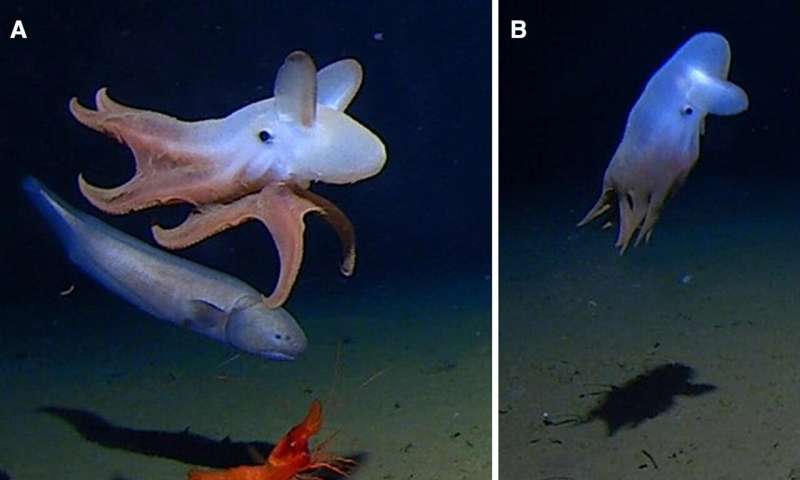June 4, 2020 report
Footage captured of cephalopod at deepest ocean level ever observed

A pair of researchers, one with Newcastle University in the U.K, the other the National Museum of Natural History in Washington D.C., has captured video footage of a cephalopod at the deepest ocean level ever observed. In their paper published in the journal Marine Biology, Alan Jamieson and Michael Vecchione describe how they used "landers" to capture video remotely at the bottom of the Indian Ocean, and what they found.
The term "lander" refers to a type of frame with deep-sea cameras affixed to it—such frames are designed to rest firmly on the ocean floor. In this new effort, the researchers sent a lander down to two locationsin the bottom of the Java Trench in the Indian Ocean. One location was 5,760 meters deep, the other 6,957 meters . Among other creatures, the video cameras captured imagery of two cephalopods, both octopuses—and both in the Grimpoteuthis family. Such octopuses are commonly known as Dumbo octopuses, because of their enlarged fins that resemble the big ears of the Disney elephant. The Dumbo seen by the lander represented the deepest level that a cephalopod has ever been observed. The prior record was 5,145 meters and it had stood for nearly fifty years.
The researchers note that the Dumbo octopuses must have extraordinary physiology to be able to withstand the pressure at such depths, noting that such adaptations would have to be at the cellular level. They also suggest that the Dumbos they recorded likely represent an entirely new species—they will have to capture specimens to confirm their suspicions. The researchers suggest that cephalopods are able to live on approximately 99 percent of the seafloor worldwide.
The study was part of the Five Deeps Expedition, a project financed by Victor Vescovo, an equity investor and explorer—he was the first person to reach the deepest parts of four of the world's five oceans. The goal of the project is to study the deepest parts of the world's oceans and to look for ways to protect the creatures that live there—the researchers note that creatures in the deepest parts of the ocean have been found to have various pollutants in their bodies, including microplastics.
More information: Alan J. Jamieson et al. First in situ observation of Cephalopoda at hadal depths (Octopoda: Opisthoteuthidae: Grimpoteuthis sp.), Marine Biology (2020). DOI: 10.1007/s00227-020-03701-1
Journal information: Marine Biology
© 2020 Science X Network





















